This post may contain affiliate links. Please read our disclosure policy.
Homemade Custard Recipe (Pastry Cream) – quick and easy to make, foolproof custard recipe that can be served on its own, or used as a cake, pie, tart and pastry filling.
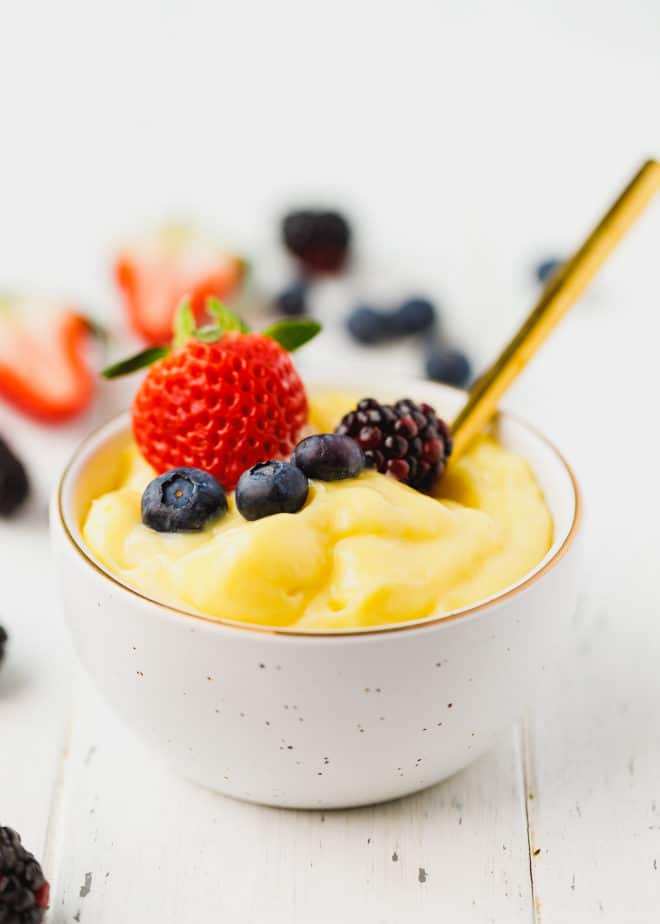
If you have been following me for a while, you may know I love baking and making pastry.
Even though I try to follow low-carb diet now, this old custard recipe that I originally shared back in June 2014 desperately needed new pictures.
This is by far my favorite way to make pastry cream.
It produces the thickest, most yellow and perfectly sweet custard that does not release water and works well as a filling in pastry, cakes, tarts or donuts. This egg custard is the best!
No more store bought powdered pudding mixes.
This is a homemade pudding made from scratch.
What is custard?
Custard is generally referred to as a dessert or sweet sauce made with milk, eggs, and sugar.
Custard is a variety of culinary preparations, based on cooked mixture of milk (cream) and egg yolk.
Some other pastry cream variations I’ve shared with you are: Bavarian Cream and Lightened Up Pastry Cream.
Most popular custards are used as desserts or dessert sauces and include sugar and vanilla.
This custard is not cooked over a double boiler. It is cooked in a saucepan on the stove top at medium-low temperature.
What ingredients do I need to make this custard?
- egg yolks
- sugar
- cornstarch
- vanilla extract or vanilla bean
- whole milk
- butter

How to make this homemade Custard (Pastry Cream)?
-
In a large pot pour milk and half of the sugar and bring to just below boil. Reduce heat to medium.
-
Keep the milk at low simmer. In a bowl whisk egg yolks.
In a separate bowl combine the remaining sugar and cornstarch.
Add egg yolks to the sugar and cornstarch mixture and whisk to combine.
!!! DO NOT MIX THE sugar, egg yolks and cornstarch too far in advance(no more than 2-3 minutes), do it when the milk is starting to boil and you are ready to add them to it.
Add 1 cup from the warm milk and carefully mix, then add mixture to the remaining warm milk and heat gently (on low heat), stirring with a wooden spoon or a whisk.
Keep stirring until custard thickens, or for 3-5 minutes.
-
Turn off heat and add butter, which will thicken the custard even more, after it cools down.
Add vanilla.Stir again and remove from heat.
You can strain custard to get rid of any lumps.
-
Transfer to a bowl and cover tightly with plastic wrap on top.
Cool to room temperature.
-
Serve at room temperature or cold.
Why is my egg custard watery?
There are many reasons why custard could turn into a watery, unusable (but not inedible) thing.
I can say that if you follow my instructions you shouldn’t run into the watery custard problem.
Here are a few reasons why egg custard might not set properly and be watery:
- The recipe and ratio of ingredients definitely can be the main reason.
- Custard made with whole eggs vs egg yolks might be more watery, because egg whites can thin it.
- Not using the correct amount of cornstarch may result in a egg custard that is not thick enough.
- Mixing the egg yolks, sugar and cornstarch too far in advance may cause the custard to become watery when cooked.
- The amount of milk is too much and the custard can not thicken.
- Not cooking the custard long enough. This homemade pastry cream needs to be cooked until thickened and it should coat the back of the spatula you are stirring it with.
- Bubbles should start to appear in the custard when done, make sure you stir constantly.
- Then you cook for 1 extra minute after you get the desired thickness, stirring constantly so it does not burn.
What temperature does egg custard set at?
This is for cornstarch thickened custards.
If you are not sure whether your custard is done, you may want to use a pastry thermometer.
Custard making is a delicate operation. A temperature increase of 3–6 °C (5–10 °F) leads to overcooking and curdling. Generally, the
temperature of a fully cooked starch thickened custard should be around 185 °F, it begins setting at 70 °C(~160 °F).
Make sure you cook at 185 F for a minute, but not more than this, since custard will overcook and become watery.
Cornstarch Based Custard Not Thickening, a Troubleshooting guide:
I’ve received some questions and concerns from readers stating that this egg yolk and cornstarch is not thickening.
Here are the main reasons why custard may not thicken:
- Make sure you mix the sugar and cornstarch together with the egg yolks no more than 3-4 minutes, before you add them to the hot milk.
- While I have not had issues with this, some readers are pointing out that if you mix them together too far in advance, custard may turn watery, due to the cornstarch looking its custard setting power.
- Don’t overcook the custard.
- It needs to be cooked to 185 F-190 F but only for 1 minute, then remove from the heat. Reaching temperatures beyond 190 F will cause watery, overcooked custard.
- Egg yolks have a starch digesting enzyme called alpha-amylase. In order for a successful thickening of the custard in the recipe, the enzyme has to be killed by cooking the custard almost to1850190 F).
- Otherwise the left-over enzymes digest all of the nice firm starch gel and your custard is nothing but liquid. (All other custard cooking methods without starch can curdle if cooked beyond 185 degrees.)
Some reputable sources on that issue:
Is custard made with eggs?
There are many variations of the traditional custard recipes and every single one of them uses different amounts and ratios of ingredients.
Some recipes call for whole eggs, others for egg yolks only.
If you are looking for thick, foolproof homemade custard recipe, I recommend using egg yolks only.
Feel free to check out my Bulgarian Funiiki Cookies Recipe, where I fill the cream horns with homemade custard made with whole eggs.
Can it be frozen?
I personally would not freeze a batch of custard, because it does not freeze well and has a tendency to separate, once defrosted.
If you make donuts for example and fill them with custard, you can freeze them.
But I don’t recommend freezing custard cakes and tarts.
Making a custard ice cream is a different story.
Most of the time (of not all) you ned to use an ice cream machine to churn the ice cream.
Baked Custard
This is not a baked custard recipe.
Baked custard usually contains whole eggs.
Creme caramel or Flan is a variation of baked custard.
When preparing baked custard, you make the egg, milk and sugar mixture, place in oven safe cups (or bowls) and bake at 300-350 F in a water bath until he custard thickens.
How to serve custard?
I enjoy eating it by the spoon full topped with some fresh berries.
You can always drizzle some chocolate sauce or sprinkle some nuts or shredded coconut on top.
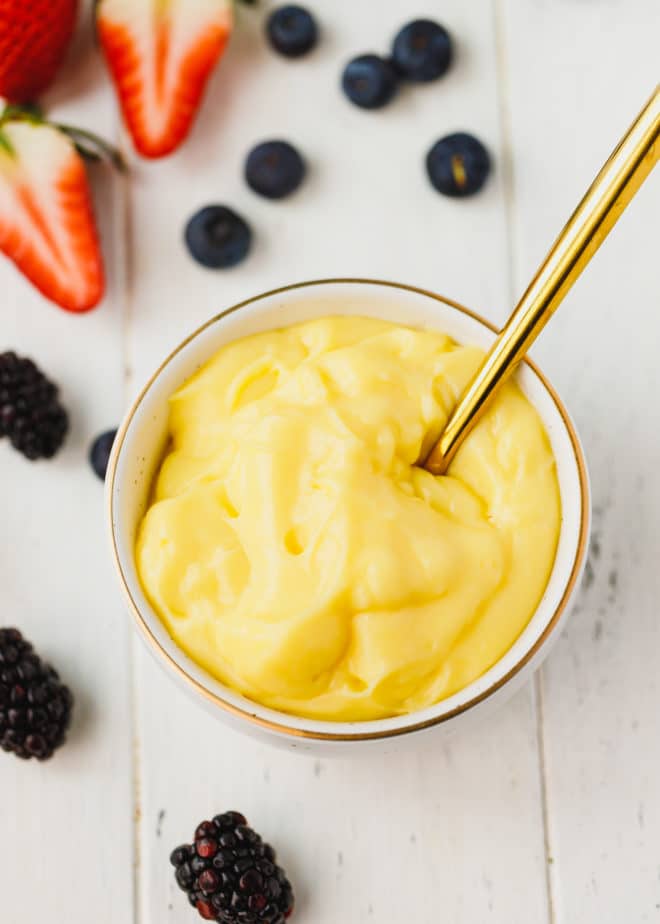
More Recipes You May Like:

Homemade Custard Recipe (Pastry Cream)
Ingredients
- 4 large egg yolks
- 1 2/3 cups whole milk
- 1/2 cup sugar, divided
- 2 tsp vanilla extract
- 3 tbsp cornstarch, (can use cornflour) TABLESPOONS
- 1 oz soft butter, unsalted
Instructions
- In a large pot pour milk and half of the sugar and bring to a boil. Reduce heat to medium.
- Keep the milk at low simmer. In a bowl whisk egg yolks. In a separate bowl combine the remaining sugar and cornstarch. Add egg yolks to the sugar and cornstarch mixture and whisk to combine.DO NOT MIX THE sugar, egg yolks and cornstarch too far in advance, do it when the milk is starting to boil and you are ready to add them to it.Add 1 cup from the warm milk and carefully mix, then add mixture to the remaining warm milk and heat gently (on medium/high heat), stirring with a wooden spoon or a whisk. Keep stirring until custard thickens, or for 3-5 minutes. This custard needs to be cooked to 185 F in order for it to become thick and not turn wattery in the fridge.
- Turn off heat and add butter, which will thicken the custard even more, after it cools down. Add vanilla.Stir again and remove from heat. You can strain custard to get rid of any lumps.
- Transfer to a bowl and cover tightly with plastic wrap on top. Cool to room temperature.
- Serve at room temperature or cold.
Nutrition
Nutrition information is automatically calculated, so should only be used as an approximation.
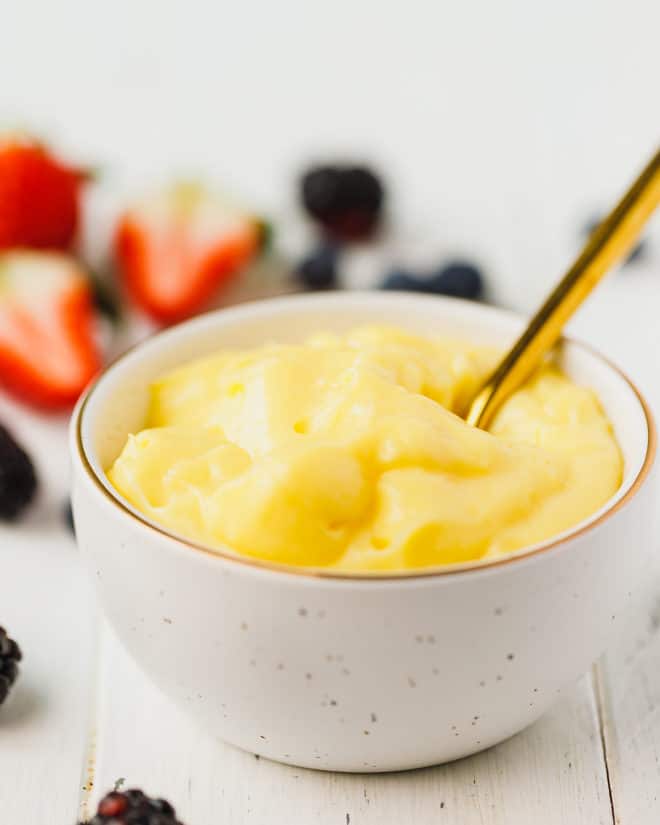

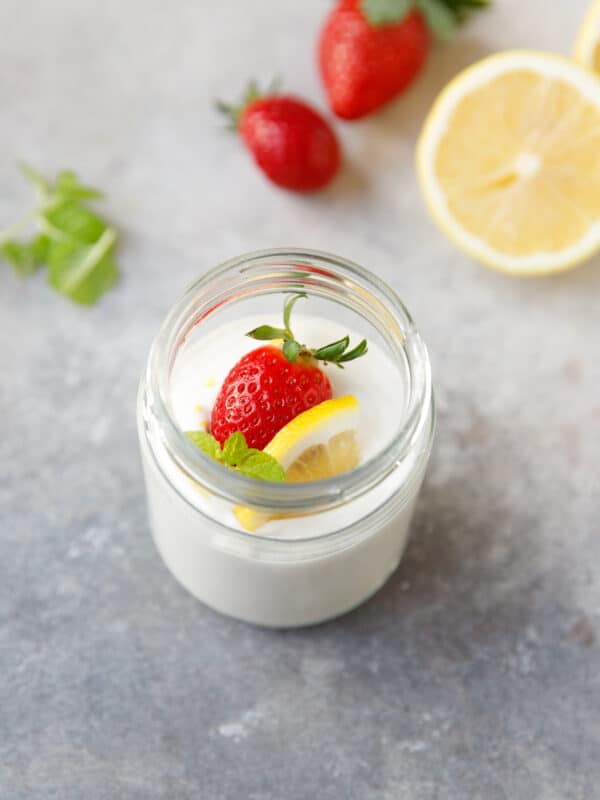
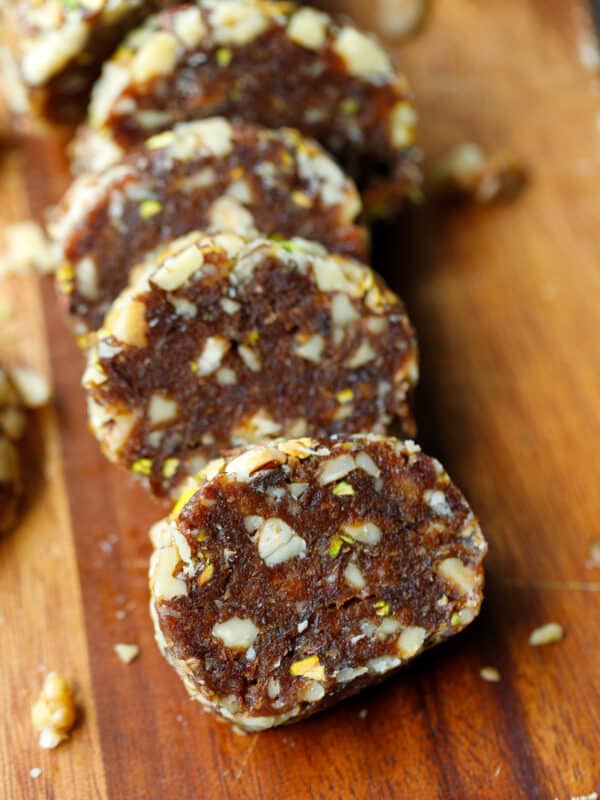


This recipe was the biggest disaster I’ve made in YEARS. I’ve made tons of custards before but this one simply shit the bed. I thought adding cornstarch to the egg yolks directly was unusual, so I did a little research and it appears that egg yolks have a starch-consuming enzyme. So, if you mix the yolks together with the starch first and let it sit there while boiling the milk, it appears the starch may become useless. I cooked for over 15 minutes at the end and it never got any thicker. This is very unusual for a starch-based custard. Sorry, but this recipe as written does not appear to result in a good final product as evidenced by the many other users who had the same issue.
I recommend mixing the cornstarch with the sugar first. Never recommended to let them sit for a while… You mix them while the milk is boiling and it takes like 5 min to boil the milk, not a while. PlEASE AKE SURE YOU FOLLOW THE RECIPE, THEN LEAVE OFFENSIVE COMMENTS. Please, refrain from words like “shit” when you make comments on my blog. Sorry the recipe did not work and I hope you find a better one.
I apologize if you found the comment offensive, but I did follow your recipe, which states “whisk egg yolks with the remaining sugar and cornstarch.” When these kinds of particular steps matter, I would recommend being as precise as possible in your instructions. For example, “wait until the milk has reached a boil before mixing the sugar, starch, and yolks.” Something like that would be my suggestion for an edit to this recipe and maybe fewer people would have issues with it thickening. It’s just frustrating to waste all those ingredients when a precaution in the recipe could have prevented it. Again, sorry if I offended you, but I just wanted to give my honest feedback and it looked like several other people had the same problem.
The step says:
While the milk is boiling, it does not state: to mix the egg yolks, sugar and cornstarch in advance.
I’ll specify not to be done in advance, since you mentioned about the egg yolk enzyme.
Yes, comments lie “shit ” are offensive, since it takes a lot of time and effort to create these recipes and please, believe me it was not my intention for the recipe not to work for you specifically. I have a lot of people who use it and works for them. Honest feedback is always welcome, but calling mine and any other blogger’s work “shit” is a little too much and as much as I love helping readers, I just don’t think it is right to tolerate it.
I’ll make sure I correct the steps, thank you for your feedback and have a great day!
In that case, I rescind my use of the word “shit,” however I did not mean to imply that the recipe was shit. I said that it “shit the bed,” meaning that it did not work. I’m sorry for offending you. I tasted the liquid custard, and it did taste good. I just couldn’t use it for anything since it was so runny. Thank you for taking my feedback into consideration, even if it was perhaps harshly worded initially.
Hi there! I have made this recipe twice with mixed results. The first time I made it I actually split the recipe in half. The custard turned out absolutely perfect! The second time I made the recipe I made the whole batch, and it turned out super runny and foamy, much like many other comments. I would advise other bakers to try splitting the recipe like I did and see if they get better results. I have a feeling it has something to do with too much liquid in the pot for various stoves with different heating ability. My stove is quite old, so I feel my milk never fully got to boil, resulting in the recipe to become liquid altogether. Great recipe but maybe edit in the recipe to try splitting the recipe depending on stove heating ability!
Hi dear, thank you so much for your feedback.
I’ve updated the recipe recently and I don’t think making a smaller batch will help with liquid custard, it is more the temperature you cook the custard to 185-190 F before removing from the heat. Cooking to lower temperature will cause it to liquify in the fridge. This is an issue with egg yolk and cornstarch based custards.
I just made this recipe and it turned out amazing! It was my first time trying to make custard and it was super quick and very easy to follow. Thank you for sharing.
Thank you M! So happy to hear you liked it!
I just made mine with this recipe. It turned out so well. But now I’m stuck because it’s still hot, should i keep it in the fridge while it’s s hot or wait for it to cool??
Wait for it to cool at room temperature, then cover tightly the top with plastic wrap and chill in the fridge.
The 2nd batch of this I made came out great! The first attempt though… Okay, I don’t know how I did this. But I accidentally switched the amounts of sugar and corn starch. So… I made it with 3.5 tbsp of sugar, and half a cup of corn starch.
It didn’t go well. So, actual custard: 10/10! My corn starch abomination: We’ll never speak of it again / 10.
Glad to hear it worked the second time, so sorry there was an accident!
So this was my first time making anything (because I don’t really cook much since I’m 15), besides things like scrambled eggs with the stuff for omlets, and other easy foods like grilled cheeses since I’m not that old. But today I decided to make custard and it turned out amazing! I made it for my parents and sisters, (idk if they liked it or not but I liked it) and on accident, I mixed a few steps up and put the vanilla in before the butter but I don’t think it changed it. Thanks for sharing this recipe, I enjoyed making it!
So glad the recipe worked for you Alyssa!
Hello Lyubomira! Thank you for posting this recipe.
I tried it at home, on a rainy evening. I made the following changes:
– I used granulated Splenda in place of sugar.
– Didn’t have whole milk, so I used what’s called “2% milk” (milk with 1/3 of the butterfat removed) and about an ounce of whipped heavy cream left over from another recipe (I had sweetened the cream with confectioners sugar before whipping it) to substitute for the missing butterfat.
– Didn’t have cornstarch, so I used Ragna’s Potato Dumpling Mix (a mixture of wheat flour and potato flour) with a pinch of all-purpose wheat flour. (You can order it here: pennfoods)
Results: Tasty! It curdled a little as it took nearly 30 minutes to reach 185 F° and thicken, but otherwise it thickened well. I actually like the little lumps – they show that it’s home-made, not store-bought. It’s cooling on the counter top right now. If all goes well after I put it in the refrigerator, I’ll use it in piirakka as a thin custard layer below a sprinkling of raspberries. I’ll report back after I’ve used it in the piirakka.
Reporting back after my custard had the chance to cool overnight in the fridge.
It’s perfect for my piirakka needs: firm yet spreadable. Later this week, when it’s cooler outside, I’m going to put it on the piirakka crusts I’ve made, top it with a raspberry-confectioners sugar mix, and bake for five minutes in a very hot (500 F°) oven.
Thanks again!
-Tamara
Hi, do you think i could use this custard go a banana pudding recipe ? Will it pour well enough? I make a great banana puddin ,nut am looking for a better custard fillimg than what i have now ???
Hello, this recipe turned out beautifully for me. I didn’t have cornflour so I substituted regular flour like one of the comments above mentioned. Thank you for this great recipe!
Great to hear that you liked it!
I always mess up making custard, but then I tired your recipe and it worked perfectly! It was my husband birthday and he wanted poppyseed cake with custard. I was freaking out about the custard part and googled fast simple recipes. He absolutely loved it and asked me to make more. Thank you so much for this recipe!
Glad the recipe worked for you!